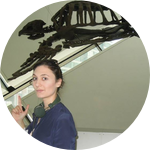About This Project
Microplastics are ubiquitous in marine sediments, and many have unique chemical signatures. This makes them ideal indicators of the Anthropocene; however, we know little about their movement as sedimentary particles and how they accumulate. This project aims to investigate the movement of microplastics via modelling in flume and wave tanks, as well as contributing to the body of evidence towards formalising the Anthropocene in the geological timescale.
Ask the Scientists
Join The DiscussionWhat is the context of this research?
Microplastics (plastics <5 mm in size) are ubiquitous in marine systems, and many that are currently used today have unique chemical signatures that are not seen in the natural world. This potentially makes them ideal indicators of the "Anthropocene", a proposed geological time period defined by human activity. They are increasingly a source of concern to scientists in a variety of disciplines due to their potential toxicity and widespread uptake in the marine food chain. They are present on shorelines and estuaries, through the water column as well as undergoing transport into seafloor sediments.
What is the significance of this project?
Much study on microplastics has been on their presence on shorelines, as well as examining their potential toxicity. This multidisciplinary project will instead investigate microplastics as geological materials, analysing their transport and deposition. We also aim to contribute to the proposal for the Anthropocene to be recognised as a formal unit of geological time, as well as providing a scientific basis for including microplastic production and management in the Law of the Sea. With this currently high on the agenda of UNEA and the UN Informal Consultative Process on Oceans and the Law of the Sea, the project could also link the geological perspective and the need to identify and address gaps in regulatory frameworks.
What are the goals of the project?
The overall goal of the project is to better understand the transport of microplastics in complex natural systems, by modelling their movement in deep water sediments as turbidites in flume tanks, and on shorelines using wave tanks, as well as testing whether the results seen in lab tests apply to the natural world using field-collected samples from a variety of marine environments. This will fill gaps in our knowledge regarding the movement and deposition of microplastics as sedimentary particles, both on shorelines and in deep sea sediments. Since a regulatory framework to classify and control pollution by marine litter and microplastics is a work in progress, our aim will also be to assist that process.
Budget
The majority of the budget will be used to cover lab fees; modelling sediment movement in water columns requires the use of specialised equipment that comes with significant costs. Colleagues working in Plymouth are currently in negotiations with COAST labs for quotes, we plan to use the facilities outside of peak times to minimise cost. Any remaining budget will be allocated back into the project. Additional funds have been allocated in the budget to facilitate my travel to Plymouth to use the facilities there for approximately 2 weeks.
The final portion of the budget covers analysis work to be undertaken in the isotope labs in the Geology and Geography departments at the University of Leicester, as well as at the BGS. These funds should cover use of the Mass Spectrometer in Leicester for the duration of the project. This is crucial for identifying plastics in samples for field-testing any models we produce.
Endorsed by
Meet the Team
Team Bio
Three institutions that will be contributing to this work, each with a different expertise; Professors Jan Zalasiewicz and Mark Williams at the University of Leicester for the geological and stratigraphic perspective, Prof. Richard Thompson at the University of Plymouth who are pioneers in the field of plastics and microplastics, and Prof. Davor Vidas at the Fridtjof Nansen Institute (FNI), experts in international law regulation, especially regarding the Law of the Sea.
Yasmin Yonan
I'm a PhD student at the University of Leicester, specialising in sedimentology, palaeobiology and palaeoclimatology. My project is focused on anthropogenic signals in marine sediments, particularly distribution of microplastics. Additionally, there are strong links with international law and we hope that by feeding back our research directly to people influencing policy we can influence positive political change. I have been interested in marine pollution ever since I can remember, and I am excited to be contributing towards work in this field. The concept of the Anthropocene is also fascinating in its own right; imagining how Homo sapiens as a species might produce a unique component of the geological record highlights the impact of our lifestyle on the natural environment.
Lab Notes
Nothing posted yet.
Additional Information
Cover photo shows a bright blue plastic fragment within carbonate-cemented beach rock on Gorrondatxe-Azkorri beach, Basque region, Spain (photo: H. Astibia in Zalasiewicz et al. 2016)
Project Backers
- 3Backers
- 3%Funded
- $79Total Donations
- $26.33Average Donation


